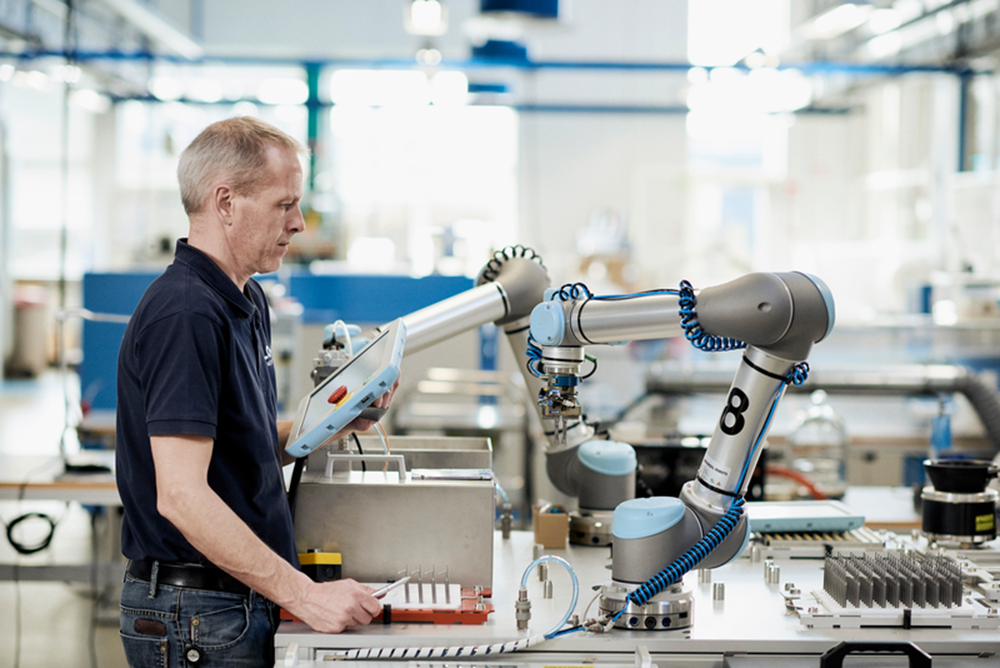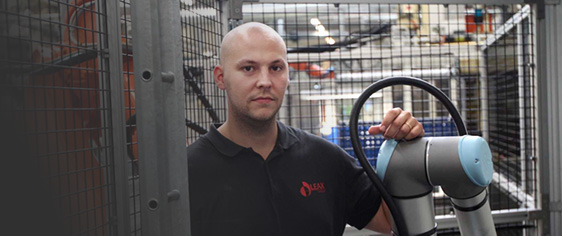Over the last two decades, the steady rise of autonomous robots fuelled a silent industrial revolution - one that consists of autonomous machines and devices. Over the years, robots have learnt to collaborate and safely work side-by-side with people and have allowed the workforce to shift its focus on more complex, important and less dangerous tasks.
What Are Autonomous Robots?
Autonomous robots are intelligent devices that you can easily program to learn about their environment and work for long hours with superhuman efficiency and little to no human intervention.
Rapidly finding use in the industrial and manufacturing sectors, these autonomous robots are multi-talented and can be programmed to perform various simple and complex tasks in production environments —namely material handling, assembly, welding, finishing, machine tending etc.
Autonomous robots are most widely used in production and manufacturing lines to perform repetitive and potentially hazardous tasks. The best autonomous robots have some version of a real-time autonomous motion control technology that allows them to navigate different routes, perform various production and manufacturing functions and adapt to thousands of work situations worldwide.
How Do Autonomous Robots Work?
As the name suggests, autonomous robots tend to function with a high level of autonomy. They can fulfil several complex tasks by themselves without any human intervention. Some autonomous robots don’t even need to be connected to a permanent source of energy. They are also surprisingly low-maintenance — self-charging, self-troubleshooting.
Essentially, autonomous robots are composed of predefined data and behaviour guidelines. Their various environmental sensors and AI-enabled software allow them to safely perform thousands of complex tasks autonomously and with astounding efficiency.
In the manufacturing industry, autonomous robots have found applications in challenging industries like automotive, metal and machining, electronics technology, plastic and polymers, and medicine.
With hazardous or chaotic elements, a production environment can sometimes be dangerous for the human workforce. A robot’s type, alignment, location, programming, and work objective can vary unpredictably in such cases. Good autonomous robots know how to adapt to such challenges and can be easily configured to perform wildly different tasks quickly.
Today, autonomous robots have a growing arsenal of cameras, infrared sensors, radio sensors, laser sensors, haptics, facial recognition tools, AI, deep-learning, and several such advanced technologies to navigate their surroundings and perform their tasks. These robots also use these tools to collect data and receive information from other data inputs like floor plans that constantly process their surroundings and make decisions in real-time. The most common application of these tools is to avoid obstacles, localise and integrate into the environment, navigate paths and plan objectives.
For example, manufacturers of autonomous robotic arms Universal Robots, collaborative robots, or Cobots are enabled with an intuitive 3-D visualisation technology. The operator has to simply move the arm to the required position or use the arrow keys on a user-friendly touchscreen.
Types of Autonomous Robots
Based on their applications, one can develop autonomous robots in various shapes, sizes and adaptations. These include aerial drones, ground robots, water-bound robots or even submarine robots. However, these autonomous robots are most widely used in limited industrial spaces like warehouses, logistic parks, and manufacturing and production setups. In the pandemic, they are also being used in hospitals and lab facilities where sanitation and isolation are essential. As technology improves, autonomous robots are bound to find more applications in daily life, like virtual assistants at home, road-cleaning, and front-desk employees that enhance customer experience.
However, the smartest automated robots in the market are categorised as intelligent collaborative robots known as Cobots. These are enabled with microprocessing capacities allowing them to learn and adapt to their surroundings to perform highly complex tasks in chaotic, dangerous situations. They are highly sensitive to human limitations and can intuitively control their force and speed to enhance ergonomics and safety. These robots are widely used in industries, education, medicine and the military.
Applications of Autonomous Robots
These days, intelligent autonomous robots are finding value-adding applications in manufacturing industries of all shapes and sizes. They are safe, agile and easy to use. Moreover, according to one study, the increase in the production of robots has lowered their costs by half in the last three decades, more so when compared to human labour. Apart from thousands of operations like welding, dispensing and material removal, here’s a look at a handful of noteworthy uses of autonomous robots in the manufacturing industry:
Autonomous robotic arms enhance the speed and quality of repetitive, accuracy-conscious assembly tasks like screw driving, insertions, fittings etc., on a variety of materials like wood, metals or plastics. For example, the end joint of Universal Robots’ UR3 robotic arm can rotate infinitely. The native torque-sensing technology of their e-Series allows the robot to perform screw driving directly, without expensive tools. These autonomous robots are highly precise, with up to +/- 30 microns of repeatability.
Autonomous robots are incredible in applications like packaging, palletising, picking and labelling. Several eCommerce, warehousing and logistics industries have deployed these robots for all their heavy lifting needs, much to the respite of their workers. They also enhance the product life cycle and control the packaging costs. Also, it ensures that the seasonality or unavailability of the workforce doesn’t impact production.
Some of the best autonomous robots have tools like sensitive grippers, cameras, and ML systems to identify and pick diverse objects. They also come with easily configurable scanning systems for efficient stock keeping.
Automating machine tending tasks maximises their efficiency and mitigates workplace injuries and property damage. By collaborating with robots on device tending objectives like CNC, injection moulding, press brakes or stamping, the supply chain can optimise its performance and reduce workforce dependency. Such robots can work on a variety of polymer and plastic supply chains.
Autonomous robots repeat tasks in a pre-approved flow with slight deviations, thus creating pristine conditions for quality inspections, measurements and testing.
For example, Universal Robots offer autonomous robotics arms that are enabled with camera vision. They are perfect for non-destructive testing and measurements in 3D as they integrate seamlessly with the existing systems and point out hair-thin defects and faults in end-of-line products.
Self-reliant robots can easily buff, polish and sand on uneven surfaces. Moreover, while performing such delicate tasks, they can intuitively adjust their force and position. These native features reduce additional overheads and reduce the need to purchase and integrate third-party machines.
Frequently Asked Questions About Autonomous Robots
Robotic autonomy is a constantly improving and evolving technology. As the gamut of its applications expands, it’s crucial to address a few essential questions arising out of its popularity. So let’s take a look:
- What are the benefits of autonomous robots?
- They reduce expenses. Intelligent autonomous robots are easy to set up and integrate, require minimal maintenance, and are easily operated.
- They can work 24x7. It is a great value addition for seasonal enterprises where continuous production can make or break a bottom line.
- They collaborate with the human workforce. It replaces operators in dangerous, injury-inducing tasks and reduces fatigue from repetitive, tedious work.
- They improve production capacities. Autonomous robots enhance the quality and speed of the output, be it on a small or large scale.
- They are agile. Since it is reprogrammable, lightweight, and flexible, it can perform many tasks efficiently and be relocated and customised.
- They are safe. In situations where these robots work alongside humans, they can be trained to minimise their force upon contact intuitively. Some high-end robots also come with the ability to reduce or stop work when humans walk in and resume the second they leave.
- What’s a great example of autonomous robots?
Universal Robot’s latest update of its UR10e cobot is the perfect example of an intelligent autonomous robot. A best-selling device, the enhanced UR10e comes with an increased payload of 12.5kg and a 1300mm reach. It has utilities across applications like palletizing, packaging, and machine tending. It’s also more versatile with material handling and comes with a 2.5kg gripper. In addition, the robot comes with a collaborative robot system that enhances the strength of human-robot collaboration.
- How are autonomous robots controlled?
As discussed earlier, autonomous robots use various depth-perception and motion sensing technologies like laser, radio, camera vision, infrared, AI and machine-learning to perform navigation, recognition, and operations tasks. However, for a human operator to control the device, one needs to use what is known as a teach pendant. In simple terms, it’s a centralised control interface that guides the motions of the autonomous robot and can be used to teach it specific trajectories, path sequences and specific locations or points in a production environment.
References
Tilley, J. (2017, September 7), Automation, Robotics, And The Factory Of The Future, McKinsey & Company, pp. 1-6. Retrieved from https://www.mckinsey.com/business-functions/operations/our-insights/automation-robotics-and-the-factory-of-the-future






